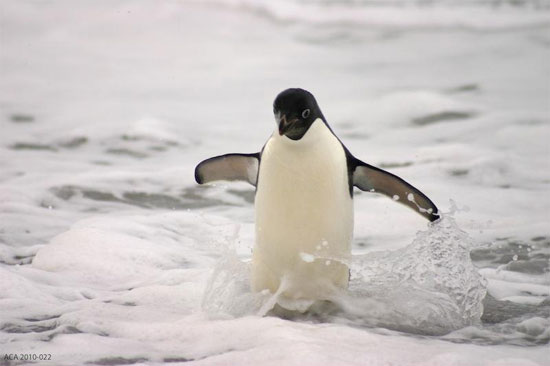Penguins are increasingly crowded thanks to the warming of the earth
- Adelie penguins can actually benefit from global warming, as opposed to other species living in the polar regions , according to a breakthrough study carried out. by an international research group led by scientists from the University of Minnesota Polar Space Center (Minnesota Polar Geospatial Center). The study provided important information to confirm the hypotheses about the impact of environmental change.
Researchers from the US and New Zealand have used a combination of old and new technologies to study a combination of aerial photographs from 1958 and modern satellite images from in the 2000s. They found that the population size of Adelie penguins in the Beaufort island area of Cam Polar is close to the Ross sea, which increased by 84% (from 35,000 pairs of broods to 64,000 pairs) when the ice blocks narrowed into the period between 1958 and 2010, with the biggest change in the last three decades. The average summer temperature in this area has increased by about 0.5 degrees Celsius / decade since the mid-1980s.
This research was published today ¾ in the journal PLOS ONE, a top rated scientific journal.
The study confirms the models published in 2010 about the response of Antarctic penguins to the changing environment when the earth's temperature increases by 2 degrees from pre-industrial levels.

Research shows that the existing habitat for Adelie penguins in the main part of the Beaufort region, on the southern coast, has increased by 71% since 1958, with an increase of 20% between 1983 and 2010. Wide range of The snow and ice to the north of the land did not change from 1958 to 1983, but then fell to 543m between 1983 and 2010.
'This study raises new questions as to how the Antarctic species are affected by a changing environment , ' said Michelle LaRue, co-author of the study and researcher at the Geospatial Center. Polar at the College of Science and Technology, University of Minnesota said. 'This article encourages us all to take a second look at what we are seeing and find out whether this type of habitat expansion is happening somewhere with the number of Adelie penguins or the Other species or not '.
The penguin researcher and co-author of the study, David Ainley, an author who led a previous study, acknowledged that the study provided researchers with important new information. .
'We learned from previous studies from 2001 - 2005 that there is a story that penguins never moved to a new flock in large numbers. When conditions were difficult, they did, ' said Ainley, a senior ecologist of wild marine animals and an environmental consulting firm at Calironia HT Harvey and Associcate. 'This study in Beaufort and the Ross Islands offers evidence of penguin characteristics that will contribute to their response to climate change'.
Adelie penguins are a common species that resides along the southern Antarctic coast. The height of this bird is smaller than their 'replica' which is the emperor penguin about 46 to 75cm (equivalent to 18-30 inches) when standing upright and weighing about 4.5 to 5, 4kg (10 - 12 pounds).
These birds only live in glacier areas but need land that is not covered by ice to breed. The average pair of parents breeds one child each year and returns to the same area to reproduce if the conditions do not change.
To determine changes in the nesting environment in this study, the researchers collected aerial photographs during penguin hatching during the 1958, 1983 and 1993 periods with High-resolution satellite images from 2005 and 2010. Researchers covered the images correctly, arranging rocks and other geographic landmarks. They studied bird droppings (poop and penguin urine) to determine the bird's habitat.
In the future, researchers plan to use additional satellite images to observe the number of Adelie penguins to help understand the dynamics and environmental factors affecting the number of birds in the area. area.
LaRue said: "This study brings together researchers from different disciplines to study all their professional contributors." "We already have people who study climate change, spatial analysis, and how this wildlife population movement is how good science leads to results".
LaRue said it is a study that brings together scientists from different fields, including experts who have done research on climate change, space analysis experts and the explosion in the number of species. wild. This research is a great achievement of science.
In addition to LaRue and Ainley, other authors include Matt Swanson, a graduate student researcher at the University of Minnesota Center for Polar Space Geography; Katie M. Dugger from Oregon State University, Phil O'B. Lyver from Landcare Research in New Zealand; Kerry Barton from Bartonk Solutions in New Zealand and Grant Ballard from PRBO California Conservation Science Association.
The research was funded primarily by the National Science Foundation (NSF).
- Earth warming, species of emperor penguins are endangered
- Emperor penguins face extinction
- Penguins use scent to identify their partners
- The pair of gay penguins adopted an egg after a long time to ... boulder incubation
- Emperor penguins can disappear forever
- How do penguins differentiate?
- Mother penguins drop eggs, the whole herd rushes to the rescue
- The deepest lake fish in Africa is increasingly scarce
- Homosexual penguins 'kidnapping' penguin child to raise
- Pair of gay penguins celebrating 10 years of living together
- A couple of penguins hold hands on the sea causing storms
- New Zealand built a tunnel for penguins
 Animal 'suffering' after hibernation
Animal 'suffering' after hibernation Why do goats climb well?
Why do goats climb well? Scientists were surprised to see chimpanzees eating turtles
Scientists were surprised to see chimpanzees eating turtles Giant catfish died deadly due to drought in Thailand
Giant catfish died deadly due to drought in Thailand